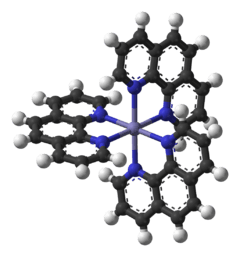Ferroin
Ferroin is the chemical compound with the formula [Fe(o-phen)3]SO4, where o-phen is an abbreviation for 1,10-phenanthroline, a bidentate ligand. The term "ferroin" is used loosely and includes salts of other anions such as chloride.[1]
 | |
| Identifiers | |
|---|---|
3D model (JSmol) |
|
| ChemSpider | |
| ECHA InfoCard | 100.035.145 |
PubChem CID |
|
CompTox Dashboard (EPA) |
|
| |
| |
| Properties | |
| C36H24FeN62+ | |
| Molar mass | 596.27 g/mol |
Except where otherwise noted, data are given for materials in their standard state (at 25 °C [77 °F], 100 kPa). | |
| Infobox references | |
Redox indicator
| Phenanthroline Fe(II) (Redox indicator) | ||
| E0= 1.06 V | ||
| Reduced. | ↔ | Oxidized |
This coordination compound is used as an indicator in analytical chemistry.[2] The active ingredient is the [Fe(o-phen)3]2+ ion, which is a chromophore that can be oxidized to the ferric derivative [Fe(o-phen)3]3+. The potential for this redox change is +1.06 volts in 1 M H2SO4. It is a popular redox indicator for visualizing oscillatory Belousov–Zhabotinsky reactions.
Ferroin is suitable as a redox indicator, as the color change is reversible, very pronounced and rapid, and the ferroin solution is stable up to 60 °C. It is the main indicator used in cerimetry.[3]
Nitroferroin, the complex of iron(II) with 5-nitro-1,10-phenanthroline, has transition potential of +1.25 volts. It is more stable than ferroin, but in sulfuric acid with Ce4+ ion it requires significant excess of the titrant. It is however useful for titration in perchloric acid or nitric acid solution, where cerium redox potential is higher.[3]
The redox potential of the iron-phenanthroline complex can be varied between +0.84 V and +1.10 V by adjusting the position and number of methyl groups on the phenanthroline core.[3]
Preparation
Ferroin sulfate may be prepared by combining phenanthroline to ferrous sulfate in water.
- 3 phen + Fe2+ → [Fe(phen)3]2+
The iron is low spin and octahedral with D3 symmetry. The intense color of this ferrous complex arises from a metal-to-ligand charge-transfer transition.
References
- Sattar, Simeen (2011). "A Unified Kinetics and Equilibrium Experiment: Rate Law, Activation Energy, and Equilibrium Constant for the Dissociation of Ferroin". Journal of Chemical Education. 88 (4): 457–460. Bibcode:2011JChEd..88..457S. doi:10.1021/ed100797s.
- Harris, D. C. (1995). Quantitative Chemical Analysis (4th ed.). New York, NY: W. H. Freeman. ISBN 978-0-7167-2508-4.
- Handbook on the Physics and Chemistry of Rare Earths. Elsevier. 2006. pp. 289–. ISBN 978-0-08-046672-9.